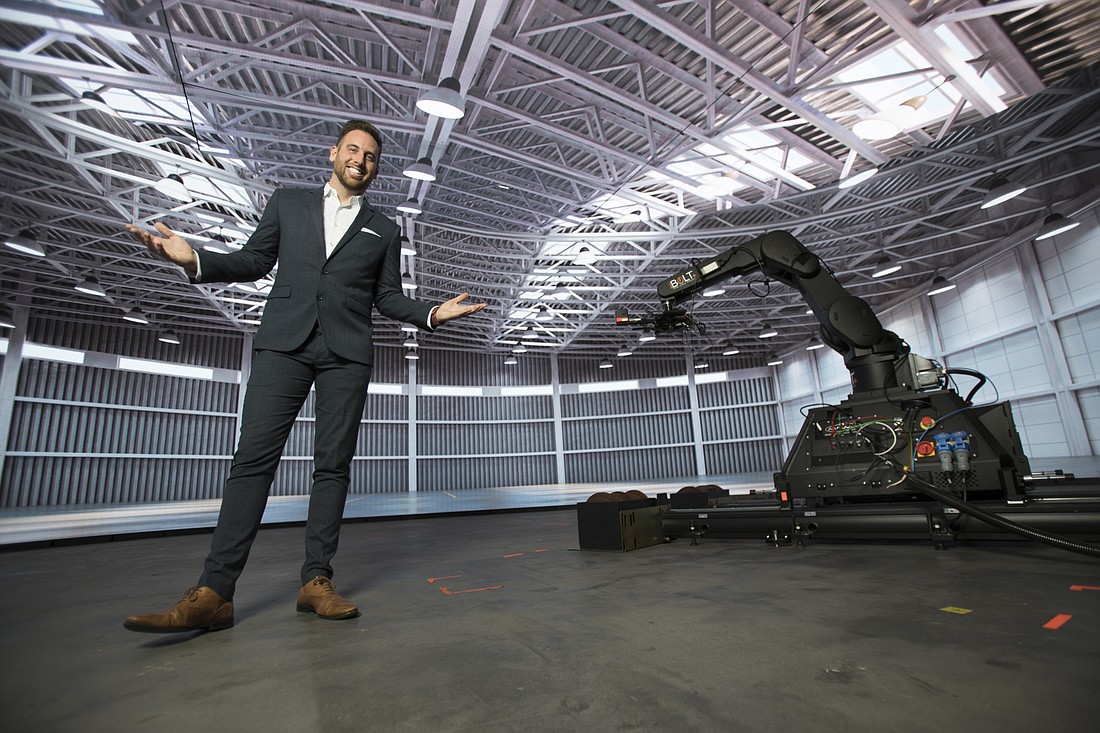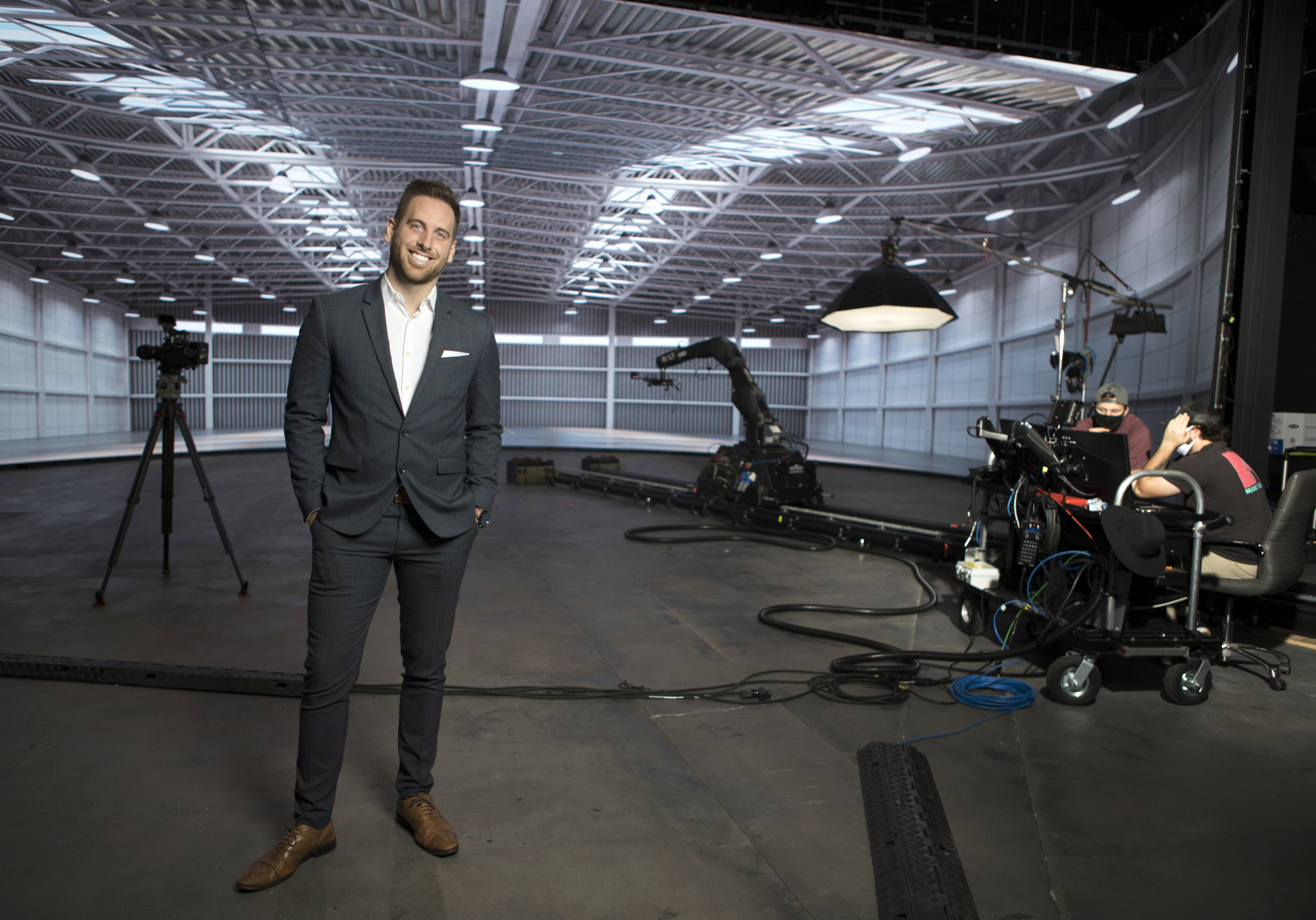- July 26, 2024
-
-
Loading

Loading

In the span of 20 minutes, a Tampa video production company transported its audience to three geographically diverse locations — all without traveling a single step.
At first, we were in a hangar-like warehouse. Then, a mountainous landscape resembling Colorado. Finally, a lush island, with plant fronds visibly blowing in the breeze. It was day, it was night, it was even the golden hour.
‘When they showed us this space, the bones of a 30-year-old mall, it took a little bit of seeing through it and past it to envision what it could be.’ Tim Moore, Diamond View Studios
Diamond View Studios founder and CEO Tim Moore, 31, is banking on that novelty. His company just invested about $7 million in the creation of a 100-foot-long LED volume virtual production wall with a patent-pending translucent LED ceiling panel. The investment, a company spokeswoman says, is a "strategic investment using Diamond View's savings over the years."
The graphics created for the wall, which is more than 18 feet high, are made in Unreal Engine, a platform for creating video games known for products including Fortnite. By creating an immersive experience with changing light and a virtual background that adjusts to where the camera is, the production quality is more true to life than something like a green screen.
The virtual production studio represents Diamond View’s real-life decision to shift the focus of its business in the pandemic. About 80% of the firm’s work takes place away from the Tampa Bay area, Moore says, so the pandemic essentially shut everything down.
Before the world stopped, Diamond View had been looking at purchasing a cigar factory in West Tampa for around $4 million. The plan was to open a coworking space and expand its studio, shooting for a closing of spring 2020. But as the pandemic grew, Moore realized coworking was the opposite of a good investment. So he shifted.
Things happened fast. In September, the company reached out to Mark Sharpe, the head of the Tampa Innovation Partnership, letting him know they were looking for a spot that had roughly 10,000 to 15,000 square feet. Sharpe suggested the former University Mall, a space being redeveloped into a mixed-use innovation area called Rithm at Uptown.
At first, it wasn’t a perfect fit.
“When they showed us this space, the bones of a 30-year-old mall, it took a little bit of seeing through it and past it to envision what it could be,” Moore says.
The store Diamond View ended up leasing — as an incentive, it got the first six months free — was originally an Anna’s Linens. The drop ceiling and green carpet made it less than desirable for a visionary studio, but Moore and his team quickly set to work changing the space. They pushed the ceilings up 12 feet, painted the walls black and exposed the HVAC and electrical systems, which gave the studio an industrial look.

Although the studio will not be open to the public until the end of January, it has already hosted four or five shoots, Moore says. One of its first clients for the LED wall system was Jack Daniels. The company wanted to be able to shoot its product in a bar or a stadium at a time when that wasn’t really possible.
Then in December, Mercedes Benz chose the Vū because the car company specifically sought an LED volume. Diamond View wasn’t even finished building its studio when an agency from New York reached out. The firm has fielded calls from multiple companies, including national big names, such as HBO and the NFL.
The cost savings are a large part of the appeal to clients. The Mercedes Benz commercial at the Vū, for example, took place in six different virtual locations. The expense of transferring a car to each location, as well as an entire crew, would have been high for Mercedes. Add to that traveling during COVID-19, and it makes these shoots almost impossible.
Renting the studio for a day costs from $30,000 to $50,000. That comes with not just technology but also operators who understand how to use the system.
Diamond View has also recently diversified its revenue streams. It’s selling its LED ceiling panel technology to interested companies, as well as consulting on proper configurations and how to operate the equipment. Overall, if Moore sees success with this model in Tampa, his eventual plan is to replicate it in other markets, such as Atlanta or Miami. While Moore declines to disclose specific revenue figures, the spokeswoman says the firm, with all the new studio work and panel sales, could do $10-15 million a year in revenue in 2021.
The Vū is a far cry from when Moore started the company in 2007 as the only employee. It took him three years to hire someone else. Now he has 30 employees.
A key lesson along the way? When Moore started, he quickly discovered being an early adopter of advanced technology set you ahead. That’s why he jumped on virtual production. It’s efficient and saves money, he says.
He points to The White House to illustrate his point. Studios build The White House about 400 times a year for commercials and movies. Then it all gets thrown away.
But what if The White House were built once, on a gaming interface, to be used on virtual reality production systems everywhere? Now that would be efficient.